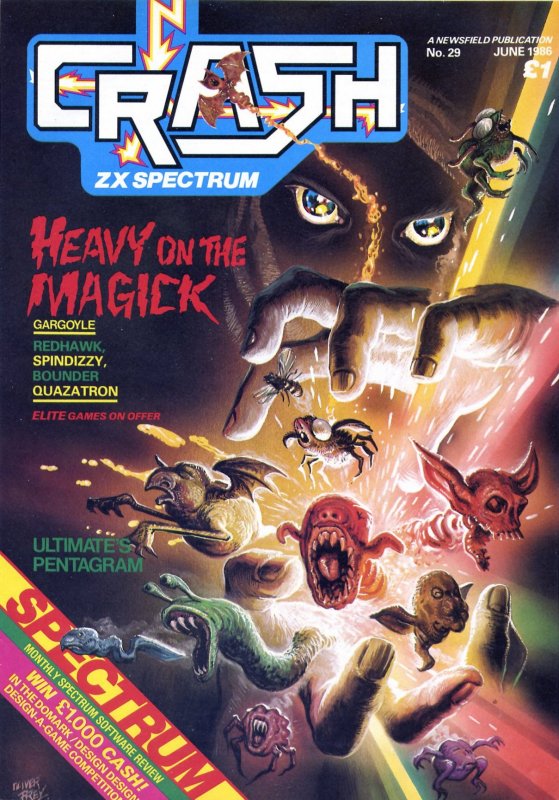

This cover was tied to Heavy On The Magick, the latest from Gargoyle Games. In the past Oliver has been happy to work with their games as cover themes, but he had little chance to see this one. However, the other options for the month’s cover had already been used for ZZAP! and AMTIX! (notably Redhawk, on AMTIX!). The editorial decision was postponed till the last moment, as was increasingly the practice, leaving only hours for the illustration to be done. Again, composition turned what could have been a weak cover into a powerful image.
CRASH was continually adding new sections. In this month John Minson went solo as his Fear & Loathing page was detached from the news, freeing him to be even more irreverent (or should that be irrelevant?) about the software industry. John had earlier done a piece about play-by-mail games, and now Brendon Kavanagh arrived to start a regular column devoted to the subject. Then there was the Art Gallery — or On The Screen, as it became known — a page of readers’ Spectrum art sponsored by Rainbird, producers of the Art Studio graphics utilities. And to top that off, we began the first of a long series (Genesis) aimed at finding the CRASH reader who could design a complete game worthy of being programmed by Design Design and marketed properly by Domark.
Domark were in need of a lift too, for after an age Friday The 13th had arrived. We were kinder than ZZAP! (they gave it an appropriate 13%), but it was still pretty dire. So was much else on the tie-in front: Ocean’s TV licence V was poorly thought-out and boring, TV’s The Young Ones fared hardly better from Orpheus, and in an attempt at a really obscure tie-in Firebird gave us The Comet Game to coincide with the arrival of Halley’s interplanetary body in our skies. The natural phenomenon was magnificent, the game was silly.
Derek had been quiet for some months, with nothing very inspiring to review, but he got Heavy On The Magick and delightedly Smashed it. Meanwhile Gary Liddon was given the task of solo reviewing — a departure from the norm — for Red Hawk, a comic tie-in from Melbourne House. That was a Smash too. So was the excellent Spindizzy, which restored Electric Dreams to some of its former glory. The Spectrum version was by Paul Shirley (aided by Phil Churchyard, who had done the Sweevo’s World screen editor for Robin Candy’s Playing Tips Supplement).
It was a great game month, because there was also the first ever 128K Smash (Knight Tyme from M.A.D.), one for Sean Masterson’s Frontline (the CCS Desert Rats), a marvellous conversion of the Commodore 64 hit Bounder (Gremlin Graphics), another for Ultimate in Pentagram, and Quazatron, an extremely clever conversion that was almost a rewrite of Hewson’s huge Commodore 64 hit Paradroid. That was by Andrew Braybrook, but Steve Turner’s Spectrum Quazatron borrowed from it and reinvented it, making it a wholly new and interesting product.
The big problem, of course, was the Playing Tips, now rudderless without Robin. The answer lay with Hannah Smith, and though she might seem in retrospect to have been an obvious choice, a lot of soul-searching went into the decision. Would a predominantly male teenage readership accept a ‘girlie tipster’ stepping into the shoes of Robin "Very Popular" Candy? We thought they just might. They did. Promoting Hannah as the ‘computer world’s first and only female tipster’ would lead to a veritable war with Computer & Video Games who claimed that their Melissa Ravenflame held that pre-eminent position. But at least readers could ring Hannah and speak with her, whereas doing the same with C&VG led to long silences. It was to lead to an attempted confrontation at the 1986 PCW Show when Melissa Ravenflame stickers running down Hannah were plastered over everything, including the Newsfield stand. Hannah issued a head-to-head challenge, which, not unsurprisingly, ‘Melissa’ declined.